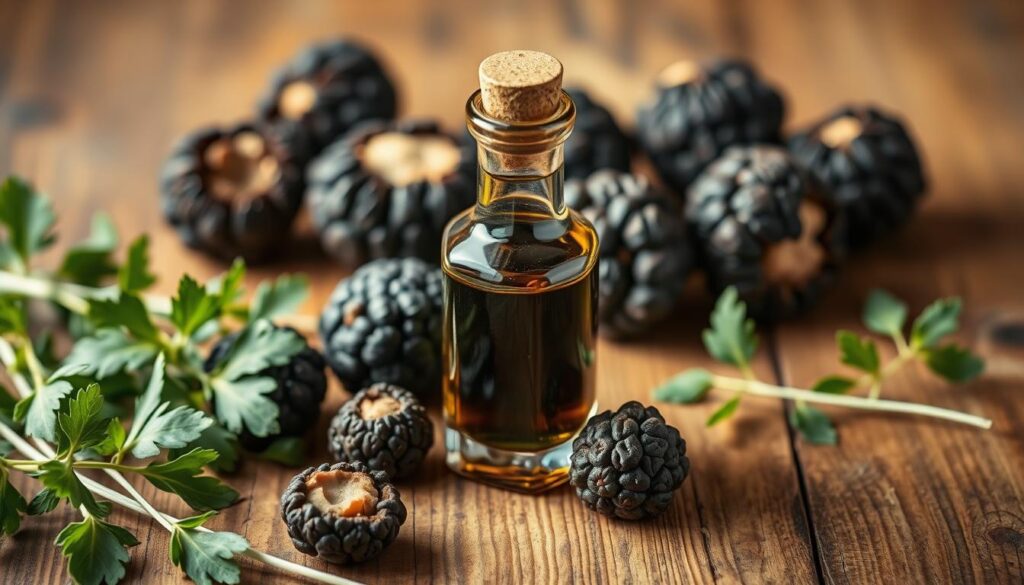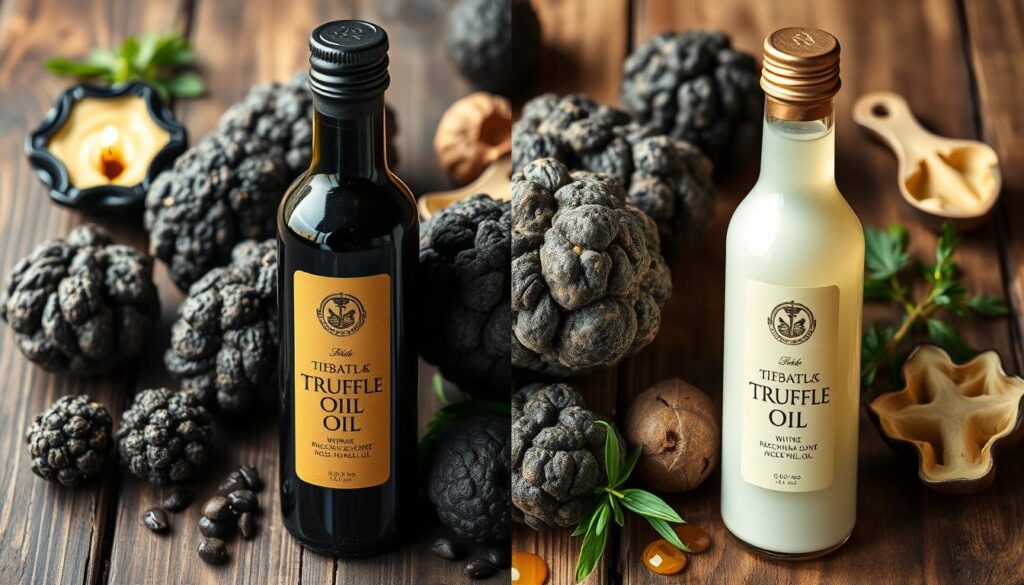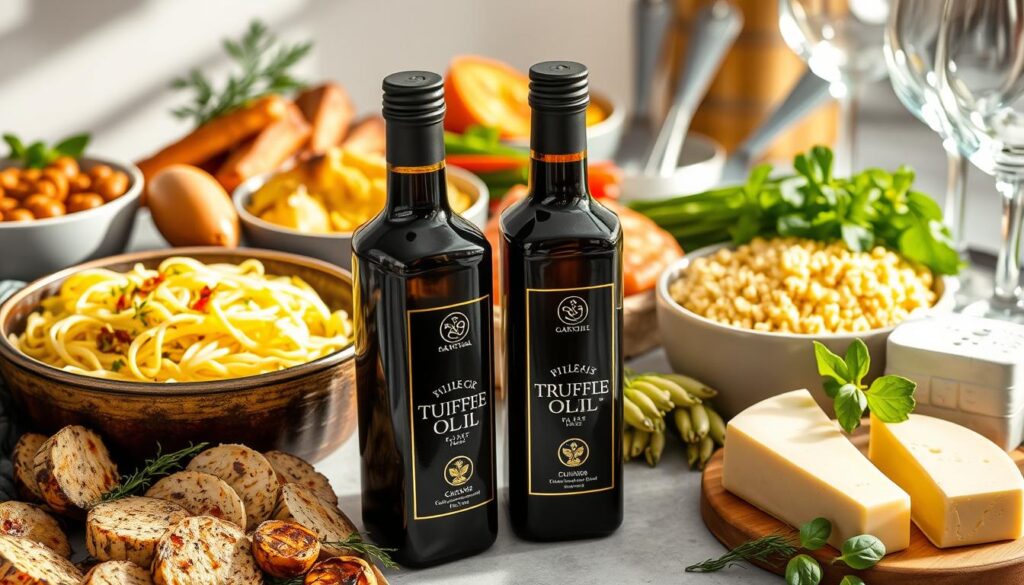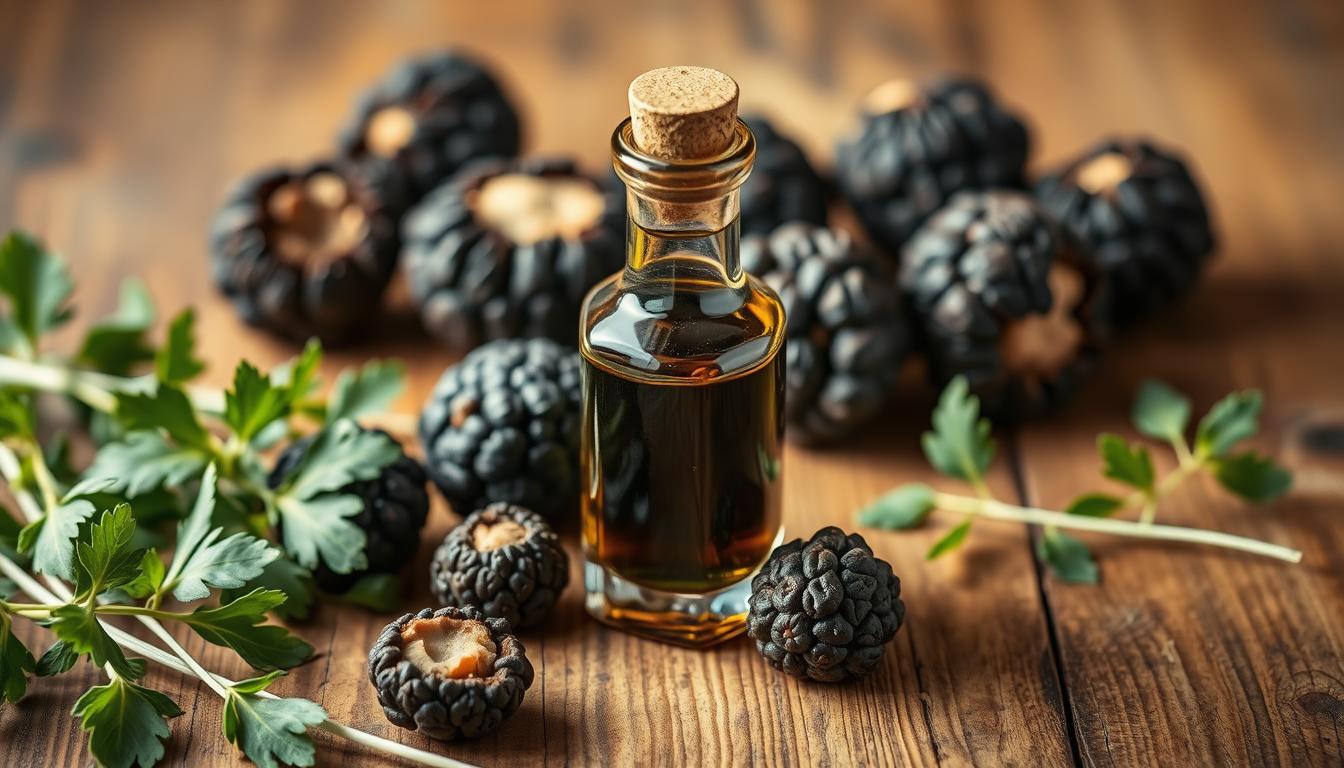Truffles are rare and expensive, known for their deep, umami flavor. There are many types, but black and white truffles are the most common. Each type gives a unique taste when turned into oil, making black truffle oil and white truffle oil different.

Knowing the differences between these oils is key. It helps you pick the best one to make your dishes stand out.
What is Truffle Oil?
Truffle oil is a tasty condiment made by mixing a base oil, like olive or grapeseed oil, with truffle essence. It’s made using a special steam extraction method. This method captures the truffle’s flavor and aroma perfectly.
Truffle Oil Production Methods
Many truffle oils sold today are not real. They use artificial flavors instead of actual truffles. These synthetic truffle oils are cheaper but don’t taste as good as natural truffle oils.
Synthetic vs. Natural Truffle Oils
Natural truffle oil production is known for its rich flavor. It’s made by soaking real truffles in oil. This way, the oil absorbs the truffle’s aroma and taste.
In contrast, synthetic truffle oils use chemicals to mimic truffle scent. They don’t have the same depth and authenticity as natural oils.
“Truffle oil was originally made by soaking truffles in olive oil before commercial truffle oil was introduced in the 1980s.”
The quality of truffle oil greatly affects its taste and use in cooking. Chefs and food lovers often choose natural truffle oils. They want to add the real aroma and taste of truffles to their dishes.
White Truffle Oil: Tuber Magnatum Pico
The white truffle oil is made by mixing a base oil, like extra virgin olive oil, with the Tuber Magnatum Pico. This white truffle is from Italy’s Piedmont region. It’s known for its light, earthy, and nutty taste, with hints of garlic.
Flavor Profile of White Truffle Oil
The smell of white truffle oil is soft and delicate. It’s great for adding flavor to many dishes without taking over. It tastes earthy, garlicky, and sweet, but is milder than black truffle oil. Because of its strong scent, use it sparingly.
“White truffle oil has a more intense aroma compared to black truffle oil.”
Unlike black truffle oil, which has a strong earthy and nutty taste, white truffle oil is more delicate. It’s perfect for salads, roasted veggies, and creamy soups. Its subtle taste can really enhance these dishes.
Quality white truffle oil is usually pricier than black truffle oil. White truffles (Tuber Magnatum Pico) are rarer and cost more than black truffles (Tuber Melanosporum).
Black Truffle Oil: Tuber Aestivum
Black truffle oil is made by mixing a base oil with Tuber Aestivum, a type of black truffle. It’s known for its strong, earthy, and woodsy flavor profile. It also has notes of dried herbs and roasted nuts. The aroma of black truffle oil is more intense than white truffle oil. This makes it perfect for hearty, savory dishes.
Tuber Aestivum, or Summer Truffle, is a favorite in cooking. It’s full of fiber, protein, carbs, and vitamins like C and minerals like manganese and calcium. It’s also packed with antioxidants, which protect cells.
The bold black truffle flavor goes great with red meats, creamy pasta, and pizza. Unlike white truffles, which have a delicate taste, black truffles have a strong umami flavor. This can make many savory dishes better.
| Truffle Type | Flavor Profile | Culinary Pairing |
|---|---|---|
| Black Truffles (Tuber Aestivum) | Robust, earthy, woodsy, with notes of dried herbs and roasted nuts | Red meats, creamy pasta, pizza |
| White Truffles (Tuber Magnatum Pico) | Delicate, garlicky, with subtle and complex notes | Seafood, risotto, egg dishes |
Using black truffle oil in cooking can make dishes stand out. Chefs and home cooks can explore the rich flavors of this amazing ingredient.
Comparing White and Black Truffle Oil Flavors
Key Tasting Notes
White truffle oil and black truffle oil both have a deep, umami taste. But they taste very different. White truffle oil is light and delicate, with a hint of garlic and onion. Black truffle oil is richer, with earthy and woody flavors, along with notes of dried herbs and nuts.
The white truffle oil has a strong, earthy smell. It’s great for adding a subtle truffle flavor to dishes like pasta and creamy sauces. Black truffle oil, on the other hand, has a complex aroma with chocolate, nut, and forest floor notes. It’s perfect for bold dishes like meats and grilled vegetables.
| Flavor Characteristic | White Truffle Oil | Black Truffle Oil |
|---|---|---|
| Aroma | Earthy, garlicky, musky | Hints of chocolate, nuts, forest floor |
| Intensity | Lighter, more delicate | Robust, earthy |
| Culinary Pairing | Pasta, risotto, creamy sauces | Meats, grilled vegetables, mushroom-based dishes |
Choosing between white truffle oil and black truffle oil depends on your taste and the dish. Both oils provide a luxurious truffle taste, fitting various dishes perfectly.

Black Truffle Oil Vs White Truffle Oil
Choosing between black truffle oil and white truffle oil depends on your taste and the dish you’re making. Each oil has its own flavor that can make your food special in its own way.
Black truffle oil is great for rich dishes like red meat, pasta, and roasted veggies. Its strong, earthy taste is perfect for these foods. It adds a deep flavor with hints of chocolate, nuts, and forest floor.
White truffle oil is better for lighter dishes like risotto, eggs, and salads. It has a subtle garlic taste and a strong, earthy smell. This makes it great for creamy dishes.
When picking truffle oil, think about the dish you’re making. Black truffle oil is best for savory dishes. White truffle oil is better for lighter, more delicate foods. Knowing the differences can help you make your dishes taste better.
Remember, synthetic truffle oils might not taste as good as real ones. Always choose high-quality, real truffle oils for the best flavor.
Culinary Uses and Pairing Recommendations
Using Truffle Oils in Cooking
Truffle oils, both black and white, are versatile ingredients that can elevate a wide range of culinary creations. These aromatic oils are best used as finishing touches, drizzled over dishes just before serving to maximize their intense flavor and aroma. Truffle oil can be used to enhance everything from eggs and pasta to meats, vegetables, and even desserts.
When pairing truffle oils, it’s important to consider the overall flavor profile of the dish and match the intensity of the truffle oil. For example, delicate dishes like risotto or salads pair well with the more delicate white truffle oil. The robust black truffle oil complements heartier fare such as steak or roasted potatoes.
- White truffle oil is best used as a finishing oil due to its low smoke point, which helps preserve its flavor intensity.
- Truffle oil can easily upgrade simple dishes like popcorn, french fries, eggs, pasta, and soup with minimal effort.
- A few tablespoons of white truffle oil are often sufficient to add a gourmet touch to a variety of dishes.
Truffle oil is commonly used in recipes like truffle mushroom and ricotta pizza, vinaigrettes, roasted potatoes, and risotto. For pasta dishes, truffle oil pairs well with various shapes like linguine, fettuccine, and farfalle. White truffle oil is also recommended for drizzling over fish before serving to enhance the dish’s flavors.
Truffle oil is favored for its ability to upgrade the flavor profile of dishes without extensive cooking processes. When using truffle oil, small amounts are suggested to avoid overpowering the dish’s original taste. The earthy and intense flavor of truffle oil adds a touch of sophistication to a wide range of culinary creations.

Truffle Oil Varieties and Products
The market now offers a wide range of truffle oil varieties. This includes classic black and white truffle oils, as well as new options. Sabatino’s White Truffle Oil and Black Truffle Oil are known for their quality. TRUFF also offers truffle-infused hot sauces and condiments.
These specialty types of truffle oil can be found in gourmet stores, online, and on producers’ websites. This makes it easy for home cooks and food lovers to add these oils to their dishes. They bring a unique and delicious flavor to any meal.
| Truffle Oil Variety | Flavor Profile | Recommended Pairings |
|---|---|---|
| Black Truffle Oil | Intense, complex flavors with hints of garlic, forest floor, and nuttiness | Meats, tomato-based sauces, vinaigrettes |
| White Truffle Oil | Delicate, nuanced flavors with subtle notes of garlic, herbs, and shallots | French fries, mashed potatoes, risotto, light pasta dishes |
Choosing any truffle oil products can make your dishes stand out. They can enhance pasta, salad dressings, and even scrambled eggs and popcorn. Types of truffle oil open up a world of flavors for both home cooks and chefs.
Conclusion
The main difference between black and white truffle oil is their taste. Black truffle oil is bold and earthy, tasting like cabbage, cauliflower, and chocolate. White truffle oil, on the other hand, is lighter and more complex, with hints of garlic, onion, honey, and mushrooms.
Knowing these differences is key when picking the right truffle oil for your dishes. Whether you want to make a simple meal better or add luxury to a special occasion, the right truffle oil can make a big difference. By understanding each type’s unique qualities, you can enhance your cooking and explore new flavors.
Choosing between black and white truffle oil depends on your taste. Black oil is earthy and strong, while white is lighter and has a garlicky flavor. Experimenting with both can help you find the perfect truffle oil for your dishes, taking them to gourmet heights.









